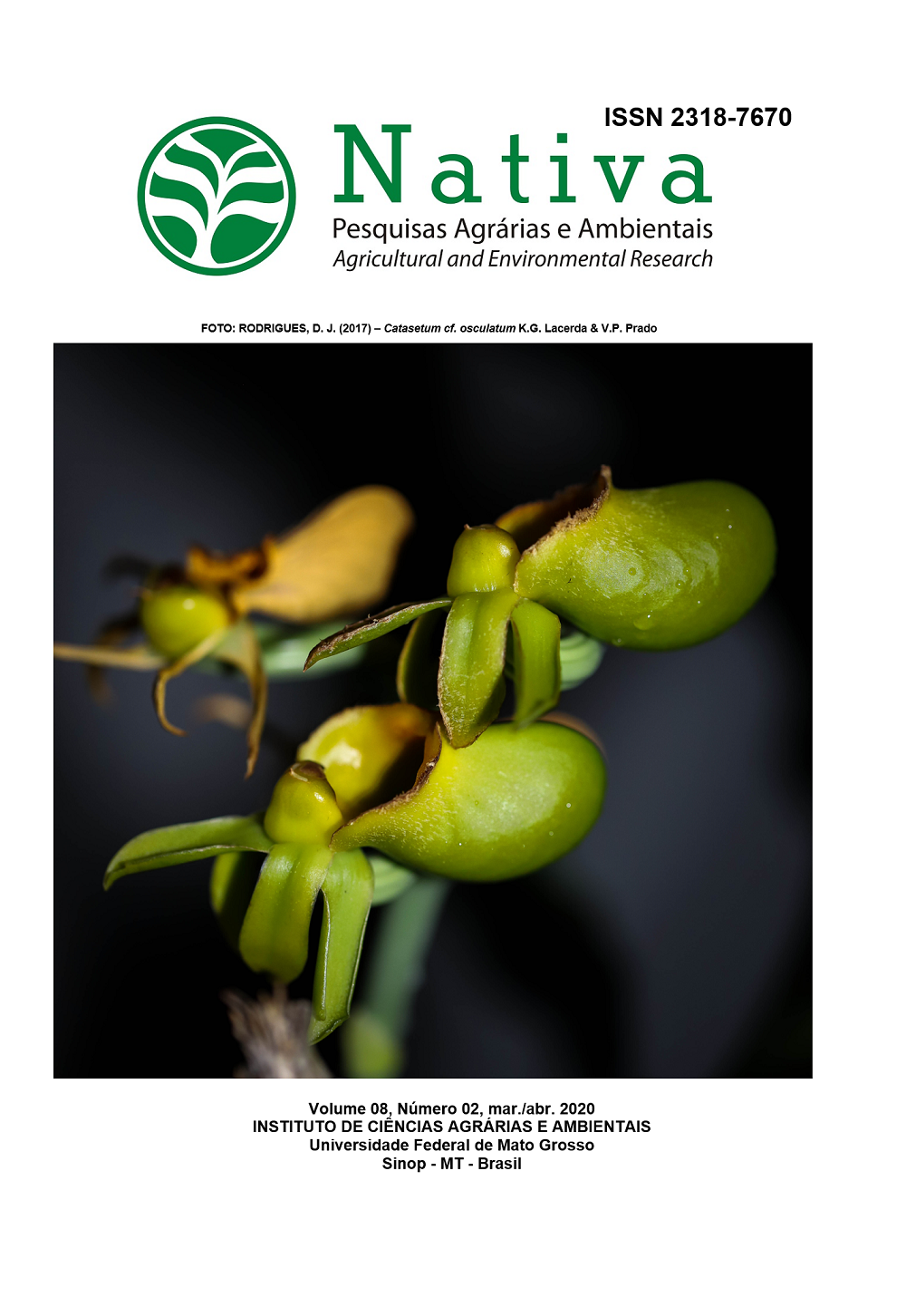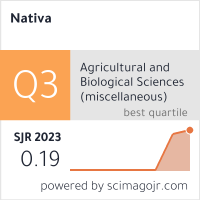UTILIZAÇÃO DE FUNGOS BENÉFICOS NA FORMAÇÃO DE MUDAS DE GOIABEIRA EM SOLOS INFESTADOS COM NEMATOIDES
DOI:
https://doi.org/10.31413/nativa.v8i2.8141Resumo
O nematoide das galhas (Meloidogyne spp.) tem sido um fator limitante ao cultivo da goiabeira no Brasil, pois restringe a produção e a qualidade dos frutos. O controle biológico vem sendo empregado para suprimir nematoides fitopatogênicos e a inoculação com Trichoderma spp. e Pochonia chlamydosporia é um método promissor, contudo poucas pesquisas são relatadas com estes fungos à cerca da cultura da goiabeira. Objetivou-se avaliar a eficiência de Trichoderma harzianum, Trichoderma longibrachiatum e Pochonia chlamydosporia na modulação morfológica do crescimento inicial de mudas de goiabeira ‘Paluma’ em solo naturalmente infestado com Meloidogyne spp. A pesquisa ocorreu na Universidade Estadual do Sudoeste da Bahia – UESB, Campus de Vitória da Conquista - BA em telado experimental. Foram realizadas as análises morfológicas altura da planta, diâmetro do caule, comprimento de raízes, massa fresca e seca da parte aérea e das raízes. Foi possível observar que os fungos de biocontrole não foram eficientes na supressão dos nematoides juvenis durante o período de avaliação, no entanto a inoculação com Trichoderma harzianum, promoveu incremento nas massas fresca e seca da parte aérea e na massa seca das raízes, Pochonia clamydosporia mostrou-se menos eficiente quanto a promoção de crescimento inicial das mudas quando comparadas a Trichoderma spp.
Palavras-chave: Psidium guajava; Trichoderma spp.; Pochonia spp.; Meloidogyne spp.
USE OF BENEFICIAL FUNGI IN DEVELOPMENT OF GUAVA SEEDLINGS IN NEMATODES INFESTED SOILS
ABSTRACT: Root-knot nematode (Meloidogyne spp.) has been a limiting factor to growing guava in Brazil since it restricts yield and fruit quality. Biological control has been employed to suppress phytopathogenic nematodes. The inoculation with Trichoderma spp. and Pochonia chlamydosporia is a promising method; however, studies on the impact of these fungi on guava trees are lacking. This work aimed to assess the efficiency of Trichoderma harzianum, Trichoderma longibrachiatum and Pochonia chlamydosporia in morphological modulation at the early development of ‘Paluma’ guava seedlings grown on a soil naturally infested by Meloidogyne spp. The study took place at the State University of Southeastern Bahia – UESB, campus Vitória da Conquista, Bahia state, Brazil, in a net house. The following morphological traits were evaluated: plant height, stem diameter, root length, and fresh and dry weights of shoots and roots. These fungi as biocontrol agents were not efficient in suppressing juvenile nematodes over the evaluation period; nonetheless, inoculation with Trichoderma harzianum increased fresh and dry weights of shoot as well a root dry weight. Pochonia clamydosporia was less efficient in promoting the early development of seedlings compared to Trichoderma spp.
Keywords: Psidium guajava; Trichoderma spp.; Pochonia spp.; Meloidogyne spp.
Referências
ADAK, A.; PRASANNA, R.; BABU, S.; BIDYARANI, N.; VERMA, S.; PAL, M.; SHIVAY, Y. S.; NAIN, L. Micronutrient Enrichment Mediated by Plant-Microbe Interactions and Rice Cultivation Practices. Journal of Plant Nutrition, v. 39, n. 9, p. 1216-1232, 2016. DOI: https://dx.doi.org/10.1080/01904167.2016.1148723
AL-HAZMI, A. S.; TARIQJAVEED, M. Effects of different inoculum densities of Trichoderma harzianum and Trichoderma viride against Meloidogyne javanica on tomato. Saudi Journal of Biological Sciences, v. 23, n. 2, p. 288-292, 2016. DOI: https://dx.doi.org/10.1016/j.sjbs.2015.04.007
AREVALO, J.; HIDALGO-DÍAZ, L.; MARTINS, I.; SOUZA, J. F.; CASTRO, J. M. C.; CARNEIRO, R. M. D. G.; TIGANO, M. S. Cultural and morphological characterization of Pochonia chlamydosporia and Lecanicillium psalliotae isolated from Meloidogyne mayaguensis eggs in Brazil. Tropical Plant Pathology, Brasília, v. 34, n. 3, p. 158-163, 2009. DOI: https://dx.doi.org/10.1590/S1982-56762009000300004
BENAVIDES, I. V.; MORA, J. D.; HERNANDÉS, T. G. Evaluación in vitro de diez cepas de hongos nematófagos para el control de Meloidogyne exigua, Meloidogyne incognita y Radopholus similis. Tecnología en marcha, Catargo, v. 30, n. 1, p. 27-37, 2017.
BIBIS, M. B.; GRUDA, N.; BLANKE, M. Potential impacts of climate change on vegetable production and product quality. Journal of Cleaner Production, Amsterdam, v. 170, p. 1602-1620, 2018. DOI: https://dx.doi.org/10.1016/j.jclepro.2017.09.224
BONTEMPO, A. F.; LOPES, E. A.; FERNANDES, R. H.; FREITAS, L. G. de; DALLEMOLE- GIARETTA, R. Dose-response effect of Pochonia chlamydosporia a gainst Meloidogyne incognita on carrot under field conditions. Revista Caatinga, v. 30, n. 1, p. 258-262, 2017. DOI: https://dx.doi.org/10.1590/1983-21252017v30n129rc
CAMPO-MARTÍNES, A. P.; ACOSTA-SANCHEZ, R. L.; MORALES-VELASCO, S.; PRADO, F. A. Evaluación de microorganismos de montaña (mm) en la producción de acelga en la meseta de popayán. Biotecnología en el Sector Agropecuario y Agroindustrial. v. 12, n. 1, p. 79-87, 2014.
CHAGAS, L. F. B.; CASTRO, H. G.; COLONIA, B. S. O.; CARVALHO FILHO, M. R.; MILLER, L. O.; CHAGAS JUNIOR, A. F. Efficiency of Trichoderma spp. as a growth promoter of cowpea (Vigna unguiculata) and analysis of phosphate solubilization and indole acetic acid synthesis. Brazilian Journal of Botany, São Paulo- SP, v. 38, n. 4, p. 1-11, 2016. DOI: https://dx.doi.org/10.1007/s40415-015-0247-6
DINARDO-MIRANDA, L. L.; PIVETTA, J. P.; FRACASSO, J. V. Influência da época de aplicação de nematicidas em soqueiras sobre as populações de nematoides e a produtividade da cana-de-açúcar. Bragantia, Campinas, v. 17, n. 1, p. 179-190, 2008. DOI:
ESCUDERO, N.; LOPEZ-MOYA, F.; GHAHREMANI, Z.; ZAVALA-GONZALEZ, E. A.; ALAGUERO-CORDOVILLA, A.; ROS-IBAÑEZ, C.; LACASA, A.; SORRIBAS, F. J.; LOPEZ-LLORDA, L. V. Chitosan increases tomato root colonization by Pochonia chlamydosporia and their combination reduces root-knot nematode damage. Frontiers in Plant Science. v. 8, p. 1415-1425, 2017. DOI: https://dx.doi.org/10.3389/fpls.2017.01415
FERNANDES, R. H.; VIEIRA, B. S.; FUGA, C. A. G.; LOPES, E. A. Pochonia chlamydosporia e Bacillus subtilis no controle de Meloidogyne incognita e M. javanica em mudas de tomateiro. Bioscience Journal, Uberlândia, v. 30, n. 1, p. 194-200, 2014.
FIPKE, G. M.; PAZINI, J. de B.; ETHUR, L. Z. Antagonismo de isolados de Trichoderma spp. ao Sclerotinia sclerotiorum em diferentes temperaturas. Magistra, Cruz das Almas, v. 27, n. 1, p. 23-32, 2015.
GALLETTI, S.; FORNASIER, F.; CIANCHETTA, S.; LAZZERI, L. Soil incorporation of brassica materials and seed treatment with Trichoderma harzianum: Effects on melon growth and soil microbial activity. Industrial crops and products, v. 75, p. 73-78, 2015. https://dx.doi.org/10.1016/j.indcrop.2015.04.030
GIURGIU, R. M.; DUMITRAS, A.; MORAR, G.; SCHEEWE, P.; SCHRÖDER, F. G. A Study on the Biological Control of Fusarium oxysporum Using Trichoderma spp., on Soil and Rockwool Substrates in Controlled Environment. Notulae Botanicae Horti Agrobotanic, Cluj-Napoca, v. 46, n. 1, p. 260-269, 2018. DOI: https://dx.doi.org/10.15835/nbha46110939
IBGE_INSTITUTO BRASILEIRO DE GEOGRAFIA E ESTATÍSTICA. Produção Agrícola Municipal. 2018. Disponível em: <https://www.sidra.ibge.gov.br>. Acesso em: 30/01/2020.
JENKINS, W. R. A. A rapid centrifugal- flotation technique for separating nematodes from soil. Plant Disease Reporter, v. 48, n. 9, 692 p. 1964.
LOPES, P. S.; RIBEIRO, R. C. F.; XAVIER, A. A.; ROCHA, L. S.; MIZOBUTSI, E. H. Determination of the treatment period of banana seedlings with rhizobacteria in the control of Meloidogyne javanica. Revista Brasileira de Fruticultura, Jaboticabal, v. 40, n. 4, 2018. DOI: http://dx.doi.org /10.1590/0100-29452018423
MACHADO, D. F. M.; TAVARES, A. P.; LOPES, S. J.; SILVA, C. F. Trichoderma spp. na emergência e crescimento de mudas de cambará (Gochnatia polymorpha (Less.) Cabrera). Revista Árvore, Viçosa, v. 39, n. 1, p. 167-176, 2015. DOI: https://dx.doi.org/10.1590/0100-67622015000100016
MARTINS, L. S. S.; MUSSER, R. dos S.; SOUZA, A. das G.; RESENDE, L. V.; MALUF, W. R. Parasitismo de Meloidogyne enterolobii em espécies de Myrtaceae. Revista Brasileira de Fruticultura, Jaboticabal, v. 35, n. 2, p. 477-484, 2013. DOI: https://dx.doi.org/10.1590/S0100-29452013000200017
MENDONÇA, L. L. R.; ALVES, F. R.; CHAGAS, E. N.; CAMARA, G. R.; SILVA, G. A.; JESUS JÚNIOR, W. C.; MORAES. W. B. Management of Meloidogyne javanica with biological pesticides and oils in a lettuce field. Nematoda, v. 3, 2016.
PAZ, R. A. O.; PIEDRAHITA, Ó. A. G.; CAYEDO, J. L. Manejo integrado del nematodo del nudo radical Meloidogyne incognita (Kofoid & White) Chitwood y Meloidogyne mayaguensis Rammh & Hirschmann] en almacigos de guayabo (Psidium guajava Linneo), variedad Palmira ICA-1. Boletín Científico Centro de Museus de História Natural, v. 19, n. 2, p. 154-172, 2015.
PINHEIRO, A. C. T.; SOUZA, L. T. O.; COIMBRA, J. L. Controle de Meloidogyne enterolobii em mudas de goiabeira com fungos micorrízicos isolados do Cerrado baiano. Revista Agro@mbiente On line, Boa Vista, v. 8, n. 3, p. 398-403, 2014.
PEREIRA, K. C.; SOARES, P. L. M.; SANTOS, J. M. dos; BATISTA, E. S. de P.; MALDONADO JÚNIOR, W. Development of guava cultivars parasitized by Meloidogyne enterolobi. Nematropica, Bradenton, v. 46, n. 1, p. 54- 59, 2016.
ROBAINA, R. R.; SOUZA, R. M.; GOMES, V. M.; CARDOSO, D. O.; ALMEIDA, A. M. Nematode trophic structure in phytotelmata of Canistropsis billbergioides and Nidularium procerum (Bromeliaceae) in the Atlantic Forest - variability in relation to climate variables and plant architecture. Nematoda, v. 2, 2015.
SABANDO-ÁVILA, F.; MOLINA-ATIENCIA, L. M.; GARCÉS-FIALLOS, F. R. Trichoderma harzianum en pré-transplante aumenta el potencial agronómico del cultivo de piña. Revista Brasileira de Ciências Agrárias, v. 12, n.4, p.410-414, 2017.
SANTOS, H. A.; MELLO, S. C. M.; PEIXOTO, J. R. Associação de isolados de Trichoderma spp. e ácido indol-3- butírico (aib) na promoção de enraizamento de estacas e crescimento de maracujazeiro. Bioscience Journal, Uberlândia, v. 26, n. 6, p. 966-972, 2010.
TAIZ, L.; ZEIGER, E. Fisiologia vegetal. 5. ed. São Paulo: Artmed, 2013. 954 p.
TIHOHOD, D. Nematologia Agrícola Aplicada. Jaboticabal: FUNEP, 2000. 473 p.
ZAVALA-GONZALEZ, E. A.; RODRIGUÉZ-CAZOLA, E.; ESCUDERO, N.; ARANDA-MARTINEZ, A.; MARTINEZ-LABORDA, A.; RAMÍREZ-LEPE, M.; VERA, A.; LOPEZ-LLORCA, L. V. Arabidopsis thaliana root colonization by the nematophagous fungus Pochonia chlamydosporia is modulated by jasmonate signaling and leads to accelerated flowering and improved yield. New Phytologist, Cambridge, v. 213, n. 1, 2016. DOI: https://dx.doi.org/10.1111/nph.14106
ZHANG, F.; GE, H.; ZHANG, F.; GUO, N.; WANG, Y.; CHEN, L.; JI, X.; LI, C. Biocontrol potential of Trichoderma harzianum isolate T-aloe against Sclerotinia sclerotiorum in soybean. Plant Physiology and Biochemistry, New Delhi, v. 100, p. 64-74, 2016. DOI: https://dx.doi.org/10.1016/j.plaphy.2015.12.017
Downloads
Publicado
Edição
Seção
Como Citar
Licença
Direitos Autorais para artigos publicados nesta revista são do autor, com direitos de primeira publicação para a revista. Em virtude de a aparecerem nesta revista de acesso público, os artigos são de uso gratuito, com atribuições próprias, em aplicações educacionais e não-comerciais.
A artigos publicados nessa revista, podem ser reproduzidos parcialmente ou utilizados como referência por outros autores, desde que seja cita a fonte, ou seja, a Revista Nativa.
Copyright for articles published in this journal are the authors, with first publication rights granted to the journal. The journal shows open access, and articles are free to use, with proper attribution, in educational and non-commercial.
The articles published in this journal may be reproduced in part or used as a reference by other authors, provided that the source is quoted.






